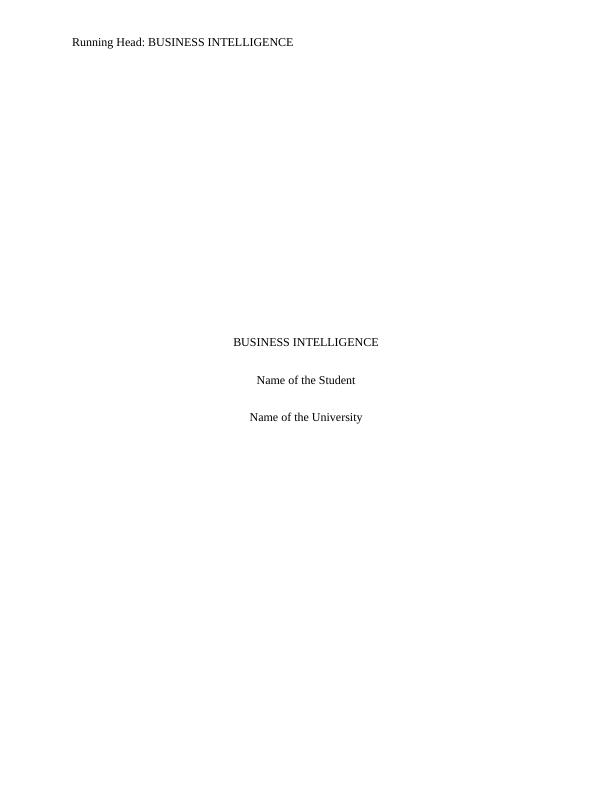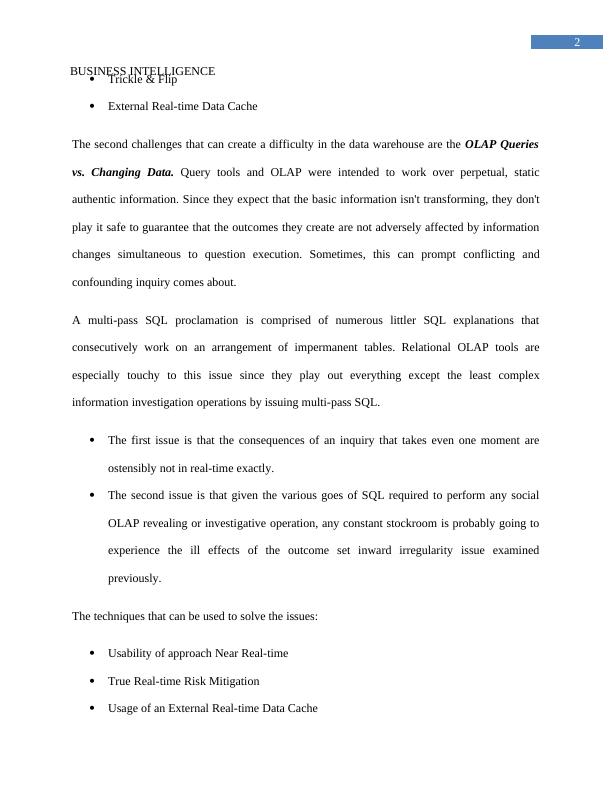ICT394 Business Intelligence Application Development
Added on 2020-05-11
6 Pages1421 Words198 Views
Running Head: BUSINESS INTELLIGENCEBUSINESS INTELLIGENCEName of the StudentName of the University

1BUSINESS INTELLIGENCETask 1: Issues creating difficulty in the creation of Data Warehouse for the given scenarioEvery organization now a day has stated utilizing the database as the centerpiece of theirgathering and storing the information for the organization. The idea of data warehousing is easilyunderstandable that is, extraction of data from one or more databases and load them to anotherdatabase for further analysis and usability. The data warehouse are generally designed to meetseveral requirements like using of non-operational data, standardizing of data since mostly inwarehouse all the data comes from different other sources, it may be possible for the data to notuse the same units or definitions. In order to make this datasets match, there is a usability ofstandard data format, this change in format is known to be extraction-transformation-load(ETL). But sometime challenges occur like Enabling Real-time ETL (challenge 1). In Real-timeperforming ETL can be a great challenge for the process of extraction, transforming, cleaningand loading of data from source systems. All the tools and systems of ETL operate in batch modeeither based upon custom-coded or off-the-shelf products. There has been a typical involvementof the downtime of warehouse, such that no users will be able to access while processing. Sincethese heaps are normally performed late during the evening, this planned downtime ordinarilydoes not burden numerous clients (Castellanos et al., 2015). When stacking informationconsistently continuously, there can't be any framework downtime. There are additionallymethods for changing existing ETL frameworks to perform constant or close ongoingdistribution center stacking. Some of these apparatuses and systems are depicted beneath. There are several techniques by which this issue can be sorted out: "Near Real-time" ETLDirect trickle feed

2BUSINESS INTELLIGENCETrickle & FlipExternal Real-time Data CacheThe second challenges that can create a difficulty in the data warehouse are the OLAP Queriesvs. Changing Data. Query tools and OLAP wereintended to work over perpetual, staticauthentic information. Since they expect that the basic information isn't transforming, they don'tplay it safe to guarantee that the outcomes they create are not adversely affected by informationchanges simultaneous to question execution. Sometimes, this can prompt conflicting andconfounding inquiry comes about. A multi-pass SQL proclamation is comprised of numerous littler SQL explanations thatconsecutively work on an arrangement of impermanent tables. Relational OLAP tools areespecially touchy to this issue since they play out everything except the least complexinformation investigation operations by issuing multi-pass SQL. The first issue is that the consequences of an inquiry that takes even one moment areostensibly not in real-time exactly.The second issue is that given the various goes of SQL required to perform any socialOLAP revealing or investigative operation, any constant stockroom is probably going toexperience the ill effects of the outcome set inward irregularity issue examinedpreviously.The techniques that can be used to solve the issues: Usability of approach Near Real-time True Real-time Risk MitigationUsage of an External Real-time Data Cache

End of preview
Want to access all the pages? Upload your documents or become a member.
Related Documents
Software Engineering for Data Warehouse Systems Presentation 2022lg...
|15
|1043
|31
Data Warehousing: Process, Problems, and Solutionslg...
|1
|547
|424
Business Intelligence and Data Visualization Analysis 2022lg...
|3
|1075
|32
Extraction Transformation Loading (ETL)lg...
|40
|4377
|29
Conceptual Analysis of Data Warehousing and Real-Time ETLlg...
|9
|1579
|95
Database Application Direction | Data Warehouselg...
|5
|799
|22
